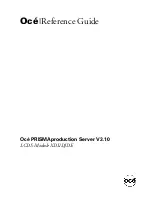
A795 User Guide: Programming Supplement
Chapter 4: Programming commands
72
Form and merge real time surround graphic (ColorPOS™)
ASCII
GS 0x90 m x y o p q
Hexadecimal
1D 90 m x y o p q
Decimal
29 144 m x y o p q
This command will print a real-time graphic style
designated by m. m = 0 rectangle, m =1 oval, m =2 ellipse
(if printed in a square area the ellipse becomes a circle),
m = 3 is a 5 point star, m = 4 is a free hand underline,
m = 5 is a free hand ellipse and other values of m reserved
for future styles. This graphic is formed into a RAM based
graphics buffer, and the buffer state is set to “graphic
merge pending”.
Whenever the buffer is in the pending merge state and
print output is started, the state will be changed to frozen
and a merge process started (logically OR-ed graphic
data) into the print lines that follow. The application
determines how close the graphic is to any printed
character data by subsequent printing of blank lines or
blank dot rows. The merge process stops when the buffer
is exhausted or its state changed (by a save graphics buffer
as logo or new form and merge real time surround
graphics command). The form and merge real time
surround graphics command can be give multiple
consecutive times, allowing the application to set up a
multi-polygon background before starting its printout with
placed text or logo.
The geometric location points for this graphic are defined
by a rectangular area start position of x bytes from the left
edge and y bytes from the top of the new line and times
o bytes wide times p bytes in length. For the case of
m =3 (star), the value passed for o is also used as the
implicit p value (passed value is ignored), i.e. a square
area. The thickness of the graphic is defined by q dots.
This will form a bit image in a RAM graphics buffer.
Subsequent surround graphic commands can be added into
(logical OR process) with expanded size if needed) the
graphics buffer until an output action is issued. It is
expected that area left white will then be (usually) filled in
with text or other data that is to be printed. Printing starts
as soon as the first line of data or other printout arrives.
After this printing is started, any new surround graphics
commands will set the graphics buffer to a merge pending
state. Example: Create different size stars and an ellipse
around a block of text.
The graphics buffer is at a frozen state at printer
initialization or reset, with blank data in it.
Each the time this command is given, the current color and
shade mode values (if any) are used for the surround
graphic, and may be changed before any subsequent
surround graphics and/or printing output. This command
may be used in page mode.
Save graphics buffer as logo (ColorPOS™)
ASCII
GS 0x91 n
Hexadecimal
1D 91 n
Decimal
29 145 n
This command will save all the raster data that is in the
working graphics buffer (where surround graphics are
formed) as a logo with index value n. This logo can then
be used repeatedly for inserting different text. See the
background logo print command.
There is one working graphics buffer in the printer; its size
(and that of the saved logo) is of maximum print width
size, and of sufficient length to store the largest of the
surround graphic styles defined since the last buffer
“freeze” event. This command is ignored if the graphics
buffer is not in a “merge pending” state. The graphics
buffer state will be set to “frozen” by this command.
Related information
This command is ignored in page mode.
















































